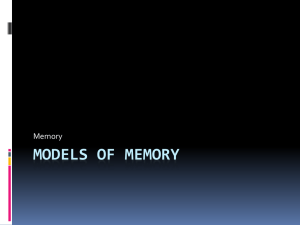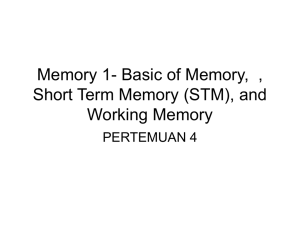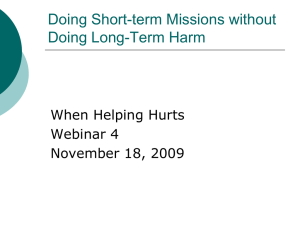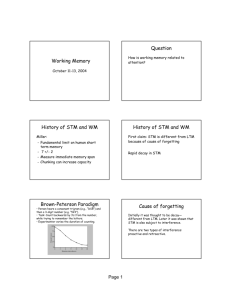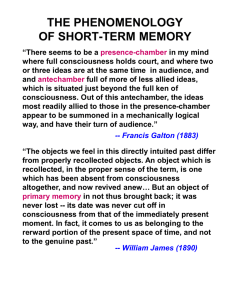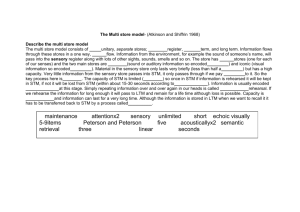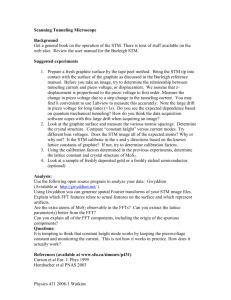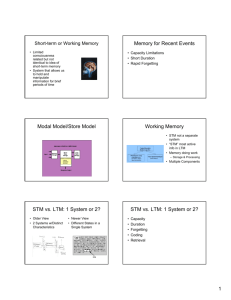Chapter 5
advertisement
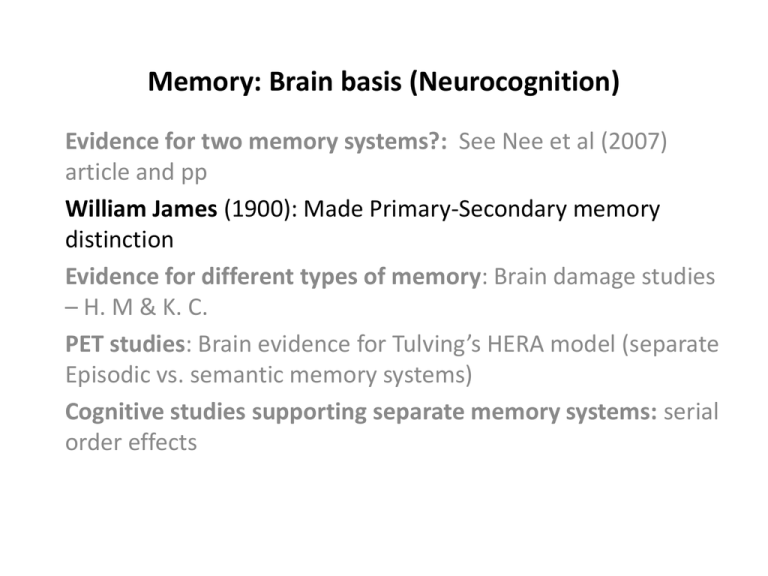
Memory: Brain basis (Neurocognition) Evidence for two memory systems?: See Nee et al (2007) article and pp William James (1900): Made Primary-Secondary memory distinction Evidence for different types of memory: Brain damage studies – H. M & K. C. PET studies: Brain evidence for Tulving’s HERA model (separate Episodic vs. semantic memory systems) Cognitive studies supporting separate memory systems: serial order effects Nee, et al., STM/LTM article • Damage to Medial Temporal produced LTM deficits while leaving STM in tact. Inferior Temporal = LT visual pattern recognition deficits Medial and Inferior Temporal lobes Perisylvian cortex: STM disruptions STM/LTM distinction: Behavioral evidence – Serial Order Effect Models of Memory 1: Boxes in Head Model of memory (Attkinson & Shiffrin, 1970’s) • • - SR – STM – LTM Each distinguishable based on: Duration Representation Loss Capacity Atkinson & Shiffrin 3 box model of memory Diagram of Three-Stage Memory Model Enhancing Memory Properties of STM: Early Studies • Waugh/Norman (1965): Early experimental test List of numbers presented 7 9 5 1 2 9 3 8 6 4 3 7 2 (tone) Tone marks repeated number; must recall number coming after repeated number first time (answer: 9) Two variables: rate of presentation: (1/sec; 4/sec Number of intervening items (1-13) If decay then rate should be critical If interference then number of items No effect of rate; significant effect of items. Memory 2: Structures and Processes STM: Processes – decay or displacement? Waugh & Norman (1965) 3 4 1 9 6 8 2 1 (beep) var: presentation rate (1-4/sec); # of intervening items (1-13). Maintenance of information in STM: necessity of rehearsal – Brown/Peterson Technique Encoding of information in STM: predominance of acoustic codes – Conrad’s confusion matrices Visual codes: Posner Paradigm, mental rotation studies Semantic codes: Wicken’s release from PI studies STM influence by both SR (early) and LTM (late) Brown/Peterson Technique: Trigram: KNP; 517; backwards by 3 from number for variable amount of time, by 15-18 seconds trigram gone Conrad’s confusion Matrix: Visually presented letters; recall in order; record mistakes; mistakes based on sound or visual image F-P or G-P Posner Paradigm: Letter matching A-a; A-A; visual significantly faster than name until about 1 sec delay. Wickens Release from PI Dogs – distracter-recall; dogs-distracter-recall; dogs-d-r; then switch Sternberg Task Search set (1-6 digits); Comparison number; yes/no part of set? Ex: 6 9 2 5 (9=yes) (7=no) RT’s increase linearly with set size; RT for yes and no equal. Serial/Exhaustive search. Mental rotation studies STM Processes (cont.) • Retrieval from STM: parallel or serial search; self-terminating or exhaustive? • Sternberg paradigm: indicates serial/exhaustive search Baddeley’s Model of Working Memory Central executive Visio-spatial sketchpad Phonological loop Episodic buffer Baddeley’s Model of Working memory



